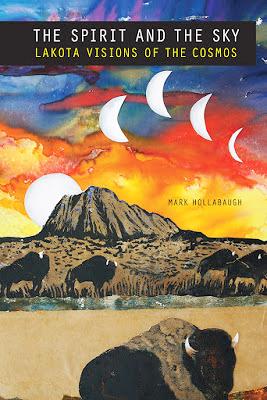 |
Canku Ota
|
 |
|
(Many Paths)
|
||
|
An Online Newsletter
Celebrating Native America
|
||
|
December 2017 - Volume
15 Number 12
|
||
|
|
||
|
The Spirit and The
Sky, A Book Review
|
||
|
by Dakota Wind
|
||
|
Astronomer's Study Of Lakota Starscape
The title of Hollabaugh's The Spirit and the Sky calls to mind Norman Greenbaum's 1969 psychedelic/gospel classic rock anthem Spirit in the Sky. I contacted the author about this, and he personally assured me that the title of his book is inspired by Lakóta star knowledge (which is touched on at the end of chapter 9). Hollabaugh's bibliography draws heavily from non-native resources who've spent considerable time learning Lak?ól Wichó?'a? (Lakota language, tradition, lifeways, philosophy) direct from the Lakóta themselves. These resources reach back through the years with specific references to winter count (pictographic records) years, and recorded oral tradition. What makes The Spirit in the Sky special is that Hollabaugh draws on carefully constructed relationships with contemporary Dakhóta and Lakóta people since the ‘90s, and fully acknowledges lasting friendships with scholars, native and non-native in his preface. A chapter on Telling Time gives readers an insight into how the Lakóta reckon a year (generally thirteen months), a month (a lunar month; from new moon to new moon), and seasons (winter is the longest, and why a year is called a "winter"). The times of the month are explained (phases of the moon) as well as times of day (position of the sun). Counting sticks are touched on briefly insofar as the Lakóta attempts to measure the months and years, which is frustrating to any who try to tack down exact times. The general acceptance of natural time in the Lakóta tradition encourages a non-reliance of exactness. What matters is Wókiksuye, or Remembrance. A chapter on Eclipses and the Aurora Borealis examines Lakóta beliefs of the two events. The eclipse is regarded as the sun's death by many Lakóta, and some reacted with fear. Some said/say that a great serpent swallows the sun, but the sun proves victorious and lives again, and some fire their guns or holler into the air in triumph. The Northern Lights have several names, and several narratives – none more important than another. Surprising to this reviewer is the connection of the Northern Lights to Wohpé (Falling Star Woman) of Lakóta myth-history, and to the Hunkáyapi (the Making-of-Relatives; when one is taken as a relative). A chapter on Stars and Constellations explores the cultural narratives of the night sky. Many of the same familiar Greek and Arabic constellations have Lakóta counterparts with equally interesting stories. The children of the Sun and Moon dance forever around one wakhán (with-energy; "holy," or "sacred") star, Wicháhpi Owánžila (The Star That Does Not Move), and those who do not, fall down as Wicháhpi Hinhpáya (Falling Stars). Hollabaugh doesn't conclude his study with the establishment of the reservation era. His work breaks that tired trope and includes an entire chapter dedicated to the living tradition of Lakóta star knowledge. It's necessary to show the Lakóta as they are today, survivors of a system that has tried to extinguish language, culture, and tradition. Some of Hollabaugh's native resources and informants are still alive and still sharing. What makes The Spirit in the Sky an essential for studies of the North American Plains is that the Lakóta relationship with the land is reflected in the sky. The Lakóta star stories are indigenous and to hear them, one must go to an elder to hear them. This book is a good place to become acquainted. The only thing that would make reading this resource better would be to read, deconstruct, and interpret each topic as it's mentioned with a Lakóta elder or other knowledgeable person. It would be a wonderful supplement if Hollabaugh or his publisher included a slideshow or an interactive online feature or smartphone application to articulate the heavens as one goes through each chapter. The Spirit in the Sky isn't hearty enough for college instructors to develop an entire course around – Hollabaugh might even agree with this, but it is solid enough to pique anyone's interest whether he or she have a passive or deep interest in the stars or Lakóta views of the heavens and earth. Make certain your local library has a copy, or get yourself one. |
||
|
|
||
|
|
||
| Canku Ota is a free Newsletter celebrating Native America, its traditions and accomplishments . We do not provide subscriber or visitor names to anyone. Some articles presented in Canku Ota may contain copyright material. We have received appropriate permissions for republishing any articles. Material appearing here is distributed without profit or monetary gain to those who have expressed an interest. This is in accordance with Title 17 U.S.C. Section 107. | ||
|
Canku Ota is a copyright ©
2000 - 2017 of Vicki Williams Barry and Paul Barry.
|
||
 |
 |
|
|
The "Canku
Ota - A Newsletter Celebrating Native America" web site and
its design is the
|
||
|
Copyright ©
1999 - 2017 of Paul C. Barry.
|
||
|
All Rights Reserved.
|
||
